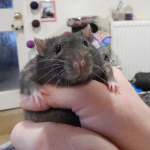Chinchillas are social and curious creatures that can be wonderful pets for those who are willing to put in the effort to care for them properly. However, before you start holding your chinchilla, it’s important to understand the basics of their behavior and anatomy. In this article, we’ll explore everything you need to know about holding a chinchilla for the first time, from proper handling techniques to safety precautions.
Understanding Chinchilla Behavior
Chinchillas are small, active rodents that love to play and explore. They are curious by nature and enjoy exploring their surroundings. However, they can also be easily frightened by sudden movements or loud noises. It’s important to approach your chinchilla slowly and calmly to avoid scaring them.
When you first bring your chinchilla home, it’s best to give them some time to adjust to their new environment before attempting to hold them. This can help them feel more comfortable and less stressed. Once they’ve settled in, you can start bonding with your chinchilla by spending time near their cage, talking to them, and offering them treats.
Preparing to Hold Your Chinchilla
Before you hold your chinchilla, you’ll need to make sure you’re prepared. This means creating a safe and comfortable environment for your chinchilla and having the proper equipment on hand.
Chinchillas have delicate bones, so it’s important to create a safe space for them to explore. Make sure there are no sharp objects or dangerous areas in the room where you’ll be holding your chinchilla. You may also want to consider using a playpen or chinchilla-proofed room to give them more space to move around.
In addition to creating a safe environment, you’ll also need to have the proper equipment. This includes a towel or small blanket to wrap your chinchilla in, as well as gloves to protect your hands in case your chinchilla bites or scratches. It’s also a good idea to have a second person present to help you if necessary.
Holding Your Chinchilla
When you’re ready to hold your chinchilla, it’s important to do so gently and with care. Chinchillas have delicate bones and can easily be injured if mishandled. Here are some tips for holding your chinchilla safely and comfortably:
- Start by wrapping your chinchilla in a small towel or blanket. This can help them feel more secure and prevent them from scratching or biting you.
- Support your chinchilla’s body with both hands. Place one hand under their chest and the other hand under their hindquarters. This will help distribute their weight evenly and prevent them from struggling.
- Keep your chinchilla close to your body. This can help them feel more secure and prevent them from jumping or falling.
- Speak softly to your chinchilla and avoid sudden movements. This can help them feel more comfortable and prevent them from getting scared or stressed.
Safety Precautions
While chinchillas can be wonderful pets, they do require special care and attention. Here are some safety precautions to keep in mind when holding your chinchilla:
- Never pick up your chinchilla by the tail. This can cause serious injury or even permanent damage to their spine.
- Avoid holding your chinchilla too tightly. They have delicate bones and can easily be injured if squeezed too hard.
- Make sure your chinchilla is comfortable and relaxed before attempting to hold them. If they are scared or stressed, they may become agitated and try to escape or bite.
- If your chinchilla bites or scratches you, wash the wound thoroughly with soap and water and seek medical attention if necessary. Chinchillas have sharp teeth and can cause deep puncture wounds.
- Supervise children when they are holding your chinchilla to ensure they are using proper techniques and handling them gently.
Bonding with Your Chinchilla
Holding your chinchilla is a great way to bond with them and build a strong relationship. However, there are other ways to bond with your chinchilla as well. Here are some tips for bonding with your chinchilla:
- Spend time near your chinchilla’s cage every day. Talk to them, offer them treats, and let them get used to your presence.
- Offer your chinchilla toys and activities to keep them entertained and stimulated. Chinchillas love to play and explore, and providing them with toys and activities can help them stay happy and healthy.
- Offer your chinchilla treats by hand to help them associate you with positive experiences. Chinchillas love dried fruits, hay cubes, and other healthy treats.
- Take your chinchilla out of their cage for supervised playtime. This can help them get exercise and socialization, and can be a fun bonding experience for both of you.
In conclusion, holding your chinchilla for the first time can be a wonderful bonding experience, but it’s important to do so safely and responsibly. By understanding chinchilla behavior, preparing properly, using gentle techniques, and following safety precautions, you can enjoy spending time with your new furry friend and build a strong relationship that will last for years to come. Remember to always approach your chinchilla with patience, gentleness, and respect, and they will reward you with love, loyalty, and companionship.







